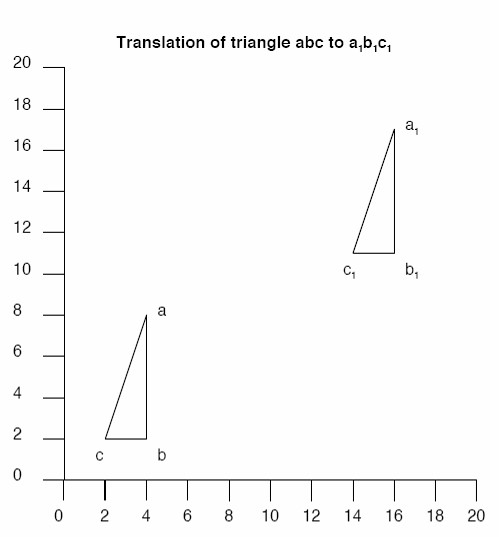Resource 4: Translating and reflecting triangles
![]() Background information / subject knowledge for teacher
Background information / subject knowledge for teacher

x-y coordinates always give the ‘x’ (horizontal axis) value before the ‘y’ (vertical axis) value.
So, in the illustration, the x-y coordinates for abc:
- a = 4, 8
- b = 4, 2
- c = 2, 2
The translation to a1b1c1 increases the value of x by 12, and y by 9. So:
- a1 = 16, 17
- b1 = 16, 11
- c1 = 14, 11
Differentiation
This can be made simple, by moving a cut-out shape around the grid, drawing around it and recording the new coordinates.
This can be made more challenging by giving coordinates for a shape and asking pupils to draw the shape. Then say how a translation affects the x-y values, and ask them to work out the new coordinates and redraw the position of the shape.

In the illustration, the x-y coordinates for abc are:
- a = 4, 8
- b = 4, 2
- c = 2, 3
Reflecting abc in a vertical ‘mirror line’ (x=8) gives an image (a1b1c1) at new coordinates:
- a1 = 12, 8
- b1 = 12, 2
- c1 = 14, 3
Note
The object and its image are always at the same perpendicular distance (distance measured at right angles) form the mirror line, e.g. if ‘a’ is 4 squares from the mirror line, ‘a1’ must also be 4 squares from the mirror line.
Compare the x-y coordinates of abc and a1b1c1 and observe that a vertical mirror line leaves the y coordinates unchanged.
Similarly, a horizontal mirror line would leave the x coordinates unchanged.
Original Source: http://www.bbc.co.uk/ schools [Tip: hold Ctrl and click a link to open it in a new tab. (Hide tip)] (Accessed 2008)
Resource 3: Translation



